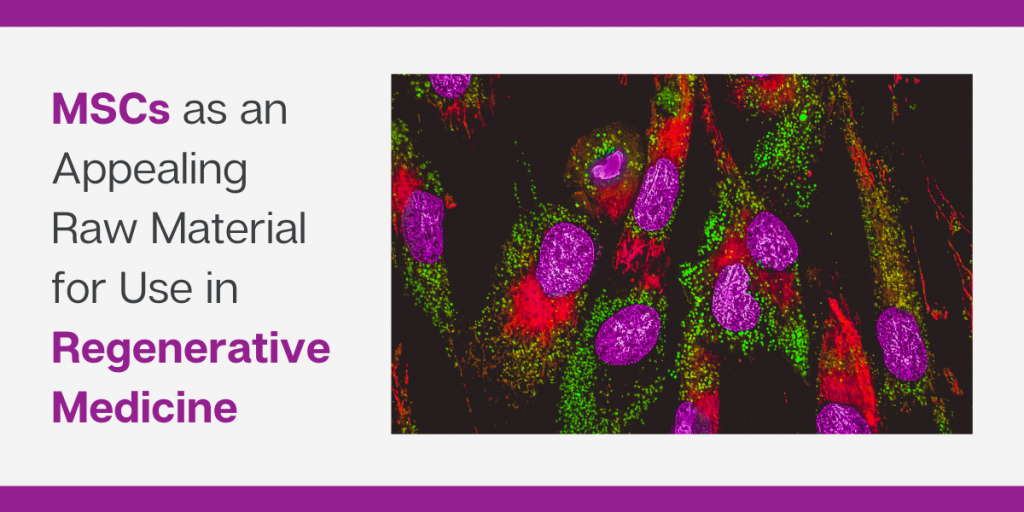Mesenchymal stem cells (MSCs) are a type of non-controversial, adult stem cell that prefers to differentiate into the specialized cells found in skeletal tissues, such as cartilage cells (chondrocytes), bone cells (osteoblasts), and fat cells (adipocytes). In contrast, stem cells derived from embryos are capable of developing into all the different types of cells found in our body, which makes them more versatile than MSCs, but also more controversial. Induced pluripotent stem cells also exhibit greater pluripotency, but as modified cells, they come with a greater set of regulatory challenges.
Therapeutic Potential of MSCs
MSCs were first described in 1991 and initially isolated from bone marrow (BM). Later, MSCs were successfully isolated from other tissues as well, including newborn umbilical cord blood (UCB), adipose tissue (AT), muscle, and dental pulp, to name a few. Because of their ability to modulate immunological responses, support hematopoiesis, and repair tissue, MSCs have been extensively tested to treat immune-based disorders, such as Crohn’s disease, rheumatoid arthritis, diabetes, and multiple sclerosis (MS).
MSCs can differentiate into a diverse range of cell types, but only if manipulated in the laboratory to do so. Their therapeutic potency lies in their ability to communicate to other specialized cells. MSCs have a distinctive capacity to survey damaged tissue and to respond by modulating the immune system and turning off inflammation. MSCs are also capable of producing trophic factors, such as cytokines and other bioactive molecules, in order to restore bodily structure and function.
Clinical Challenges of MSCs
Although mesenchymal stem cells (MSCs) have been explored within clinical trials since 1995, the outcomes of these studies have often fallen short of expectations, despite encouraging pre-clinical animal data collected across a wide array of disease models. Most clinical trial failures have been caused by important biological and pharmacological disparities in pre-clinical research and human translational studies.
To overcome these challenges, some researchers are now exploring engineered MSCs. The first MSC-based cell therapy product was approved in 2010 in South Korea. Between 2010 and 2018, only ten MSC products have gained marketing approval and none of them within the U.S.
Since 2018, the sub-optimal outcomes of MSC clinical trials have also forced some researchers to shift their attention to MSC-derived exosomes. Currently, ClinicalTrials.gov reports there are 197 ongoing clinical trials involving exosomes derived from various cell sources, with five of these trials are using MSC-derived exosomes.
When whole MSCs are administered to replace damaged or lost cells, the MSCs are usually observed to cleared out of the body. Thus, the therapeutic effect provided by MSCs appears to be propagated by cytokines, proteins, lipids, and pieces of nucleic acids delivered to the recipient tissue through exosomes secreted by administered MSCs.
MSCs Clinical Trials
In the clinical trials involving MSCs reported by ClinicalTrials.gov (the world’s largest clinical trial registry), the majority of the studies use adipose-derived MSCs or bone marrow-derived MSCs. Nearly three-quarters (75%) of the clinical studies use MSCs as regenerative medicine (RM) products. About 14% of the studies are using MSCs for disease modeling, and the remaining 11% of the studies are using MSCs for drug discovery and cytotoxicity testing applications.
Because MSCs prefer to differentiate into chondrocytes, osteocytes and adipocytes, most of the studies target musculoskeletal diseases, such as arthritis. The other major indications being treated with MSCs include spinal cord injuries, cardiovascular diseases, and critical limb ischemia (CLI).
The Impact of MSCs on Regenerative Medicine
MSCs has several fascinating properties, including their immunomodulatory effects, differentiation potential, and ability to repair damaged tissues, combined with their easy availability from different sources.
These traits have prompted scientists and researchers to investigate MSCs as an appealing raw material for use in cell therapy, gene therapy and tissue engineering applications—the three pillars of regenerative medicine.
Between 2010 and 2020, PubMed.gov has published 50,462 scientific papers on MSC-related studies. During the same period, PubMed.gov has also published 603 clinical trial related papers on MSCs. The cumulative efforts of scientists, researchers, and life science companies has resulted in the development of 10 MSC-based approved therapeutics and 19 MSC-based approved bone matrices for commercial use.
These advances are ushering in an exciting new era for MSC-based regenerative medicine, with strong potential for clinical translation of emerging technologies. Such technologies include the bioengineering of MSCs to allow them to perform targeted functions, using MSC-derived exosomes instead of whole cells, and the use of MSCs in large numbers within emerging the clean meat industry. Lab-grown meat is fast becoming a real alternative to its farm-grown counterpart as billionaire investors notice the trillion dollar potential of the “cellular agriculture” field.
